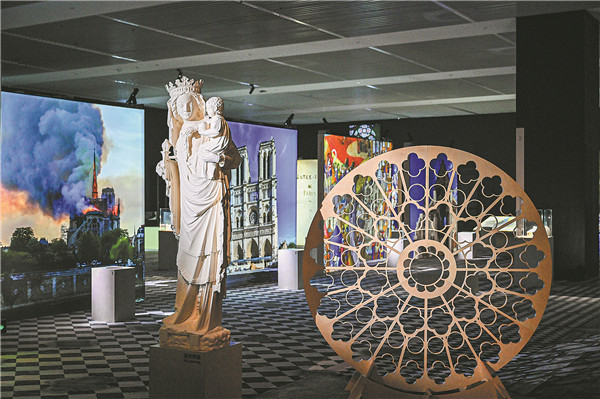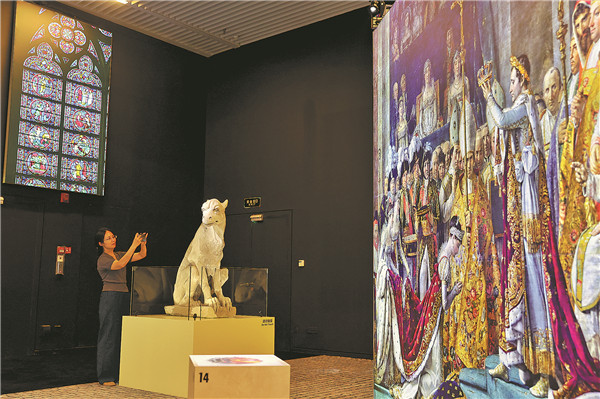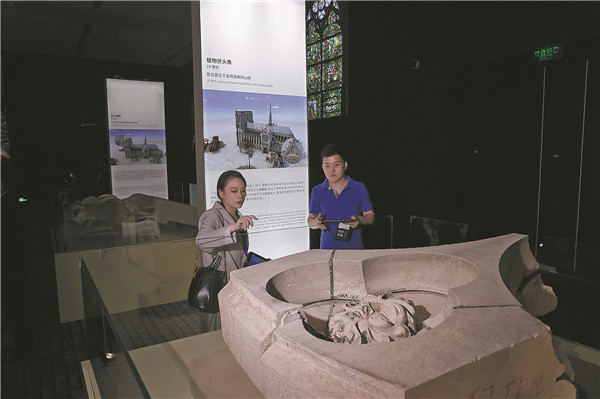
A visitor walks past an artifact on display at Notre-Dame de Paris, the Augmented Exhibition at the National Museum of China in Beijing. [Photo by Jiang Dong/China Daily]
Immersive digital experience offers Beijing audience a glimpse of the history of Notre-Dame, Lin Qi reports.
One of the touching moments at the opening ceremony of the Olympic Games Paris 2024 was a performance on the Notre-Dame Cathedral scaffolding to music mixed with the sound of construction tools, at the end of which an actor portraying Quasimodo, the central character in Victor Hugo's The Hunchback of Notre Dame, also appeared.
It was a tribute to this Gothic architectural masterpiece, and to those involved in the restoration work so that the church can be able to reopen in December.
On April 15, 2019, people on the Parisian streets watched, in disbelief, shock and grief, smoke and fire engulfing the Notre-Dame. A nine-hour blaze destroyed most of the roof.
That mixed feeling was felt by the rest of the world as photos and live footage of the massive fire circulated in news reports and on social media.
The tribute to the Notre-Dame at the Paris Olympics' opening ceremony raised people's anticipation of the reopening.
As people await the arrival of that exciting moment, it would be worthwhile to spend some time at Notre-Dame de Paris, the Augmented Exhibition, a digital show which offers people a virtual dive into the history of the architecture through an immersive and interactive journey.
Developed by the French startup Histovery, the project premiered at the France Pavilion of the Dubai World Expo in 2021 and has since toured cities around the world. Now, it has come to the National Museum of China in Beijing, running until Sunday.
Surrounded by floor-to-ceiling screens with photos and re-created images of the Notre-Dame over its 850 years, people will be traveling back in time, to different periods of the architecture.
It is made possible by a HistoPad, a new digital tool that takes visitors back to the past with its augmented reality reconstructions, and that the audience can hold while at the exhibition. The equipment ushers them into a trove of texts, drawings, images and digital reconstructions, about its birth, architectural complexity, aesthetic brilliance and the scars that time and social transformations have left on it, as well as the restoration now underway.
Zhu Xiaoyun, the exhibition's co-curator from the National Museum of China, says: "We hope to offer people, especially the young ones who grow up with the advancement of digital technology, this immersive experience — a way they are familiar with and favor — to feel the charm of Notre-Dame, to listen to its stories passed on for centuries, and to understand the importance of cultural heritage and its conservation and protection."

Floor-to-ceiling screens display photos and re-created images of the Notre-Dame over its 850 years of history. [Photo by Jiang Dong/China Daily]
She says the experience is unique on a new level, for it is based on an integration of the use of augmented reality and the display of four artifacts that once adorned the cathedral, which have been brought to China for the first time, thanks to the cooperation between the two countries.
The objects are an early 13th-century Gothic capital — the uppermost part of a column — and three sculptures from the 19th century, a chimera, a foliate head and a gargoyle, which witnessed the church's history through thick and thin.
The exhibition is due to the exclusive sponsorship of the L'Oreal group, in collaboration with the Public Institution in charge of the conservation and the restoration of the Notre-Dame Cathedral in Paris.
Lan Zhenzhen, president of public affairs for L'Oreal North Asia and China, says as a French company, they have hoped to celebrate the 60th anniversary of the diplomatic relation between China and France by organizing a series of events including Notre-Dame de Paris, the Augmented Exhibition.
She says the exhibition shows the group's concern for young people, the seeds of hope to make the world better, and offers an opportunity for them to understand the past and present of the Notre-Dame, and the art of China and France.
Zhu, the curator, says the exhibition sheds light on what else people can do when cultural heritage suffers from severe calamities like a fire, and how museums can contribute to the conservation and restoration work, by utilizing technology to make attempts creative and innovative.
"It would take as long as four hours to tour the exhibition and read through all the contents on the tablet. It will offer people a moment of quietness and peace, and help to create an intimate space for themselves alone to listen to the cathedral, to build a link with it, being undisturbed," she says.
"And by doing so, people can find the differences and similarities in our cultures, and the younger generation, in particular, will be touched and find the impetus to anticipate a shared future."

The show integrates the use of augmented reality and display of artifacts. [Photo by Jiang Dong/China Daily]

Highlights include a 19th-century chimera sculpture. [Photo by Jiang Dong/China Daily]

Highlights include an early 13th-century Gothic capital. [Photo by Jiang Dong/China Daily]